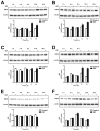The expression of keratin 6 is regulated by the activation of the ERK1/2 pathway in arsenite transformed human urothelial cells
- PMID: 28501331
- PMCID: PMC5649386
- DOI: 10.1016/j.taap.2017.05.007
The expression of keratin 6 is regulated by the activation of the ERK1/2 pathway in arsenite transformed human urothelial cells
Abstract
Urothelial cancers have an environmental etiological component, and previous studies from our laboratory have shown that arsenite (As+3) can cause the malignant transformation of the immortalized urothelial cells (UROtsa), leading to the expression of keratin 6 (KRT6). The expression of KRT6 in the parent UROtsa cells can be induced by the addition of epidermal growth factor (EGF). Tumors formed by these transformed cells have focal areas of squamous differentiation that express KRT6. The goal of this study was to investigate the mechanism involved in the upregulation of KRT6 in urothelial cancers and to validate that the As+3-transformed UROtsa cells are a model of urothelial cancer. The results obtained showed that the parent and the As+3-transformed UROtsa cells express EGFR which is phosphorylated with the addition of epidermal growth factor (EGF) resulting in an increased expression of KRT6. Inhibition of the extracellular-signal regulated kinases (ERK1/2) pathway by the addition of the mitogen-activated protein kinase kinase 1 (MEK1) and MEK2 kinase inhibitor U0126 resulted in a decrease in the phosphorylation of ERK1/2 and a reduced expression of KRT6. Immuno-histochemical analysis of the tumors generated by the As+3-transformed isolates expressed EGFR and tumors formed by two of the transformed isolates expressed the phosphorylated form of EGFR. These results show that the expression of KRT6 is regulated at least in part by the ERK1/2 pathway and that the As+3-transformed human urothelial cells have the potential to serve as a valid model to study urothelial carcinomas.
Keywords: Arsenite; Biomarker; Bladder cancer; Keratin 6; MAPK; UROtsa.
Copyright © 2017 Elsevier Inc. All rights reserved.
Conflict of interest statement
The authors declare that they have no competing interests.
Figures










References
-
- Akdas A, Turkeri L. The impact of squamous metaplasia in transitional cell carcinoma of the bladder. Int J Urol Nephrol. 1990;23:333–336. - PubMed
-
- Bellmunt J, Hussain M, Dinney CP. Novel approaches with targeted therapies in bladder cancer. Crit Rev Oncol Hematol. 2003;46:85–104. - PubMed
-
- Black PC, Agarwal PK, Dinney CP. Targeted therapies in bladder cancer - an update. Urol Oncol. 2007;25:433–438. - PubMed
Publication types
MeSH terms
Substances
Grants and funding
LinkOut - more resources
Full Text Sources
Other Literature Sources
Medical
Research Materials
Miscellaneous

